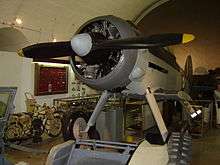Hal Far Fighter Flight

The Hal Far Fighter Flight was a British fighter unit formed during the Siege of Malta in 1940. For several weeks, the island of Malta was protected by a small force of Gloster Sea Gladiator biplane fighters, based at RAF Hal Far, which was also known as the Fleet Air Arm station HMS Falcon. The flight is the source of the myth that only three aircraft, named Faith, Hope and Charity formed the fighter cover for the island.[1] [2] In fact, more than three aircraft were operational, though not always at the same time; others were used for spare parts.[3] The names Faith, Hope and Charity were applied to the aircraft many months later, by a Maltese newspaper.[4]
Background
Crates containing 18 Sea Gladiators Mark I (serial numbers N5518 – N5535) from 802 Naval Air Squadron, were left at Malta in early 1940 by HMS Glorious. Three of the airframes (N5532, N5533 and N5534) were later shipped to Britain to take part in the Norwegian campaign and another three were sent to Egypt. In March, although Malta was not facing attack, it was decided that six Gladiators would be assembled to form an air defence unit. The Hal Far Fighter Flight was to include both FAA and Royal Air Force personnel. Five aeroplanes were eventually assembled, including N5525, N5527, N5530 and N5533 but a few days later, they were dismantled again.
In April, it was decided that Malta had a need for fighter protection and although the Gladiators were obsolete, they could hold their own in air combat against Regia Aeronautica bombers. N5519, N5520, N5522 and N5531 were assembled and test-flown. Two of these were to be used for normal operations, one was kept for spares and the other was kept in reserve. (Another source states that the aircraft assembled in April were N5519, N5520, N5523, N5524, N5529 and N5531; N5518, N5521, N5522 and N5525-28 and N5530 were to be the spares.) In May, N5524 and N5529, were assembled and other crated aircraft were to be used as spares. On 11 June 1940, when the air battle for Malta began, the air defence consisted of four Gladiator aircraft, two of which maintained a continuous stand-by during daylight hours.[5] N5520, better known as Faith, was fitted with an engine salvaged from a Bristol Blenheim bomber, which also used the Bristol Mercury engine and a Blenheim three-blade Hamilton propeller, rather than the standard two-blade propeller.
Air raids begin

By June, two of the Gladiators had crashed and two more were assembled.[6] On June 10, Italy entered the war. That same day 10 Cant Z.1007 bombers of the Regia Aeronautica attacked Grand Harbour and Hal Far. In early raids, the Italian crews bombed from around 5,500 m (18,000 ft) and later reduced the bombing altitude to 3,000 m (9,800 ft), to improve their accuracy. A reporter, Mabel Strickland claimed that "the Italians decided they didn't like [the Gladiators and AA guns], so they dropped their bombs [30 km (19 mi)] off Malta and went back."
Four Hawker Hurricanes joined the Sea Gladiators at the end of June and the flight became part of No. 261 Squadron RAF. Charity was shot down on 29 July 1940 and its pilot, Flying Officer (F/O) P. W. Hartley, was badly burned. Hope was destroyed in an air raid on 4 February 1941 and Faith survived the war. The fate of at least five more Gladiators that saw action over Malta is not as well documented. Sea Gladiators N5513 and N5535 were taken over by No. 33 Squadron RAF, in May 1941 (suggesting that the serial number usually allocated to Hope is incorrect).[7]
The fuselage of Faith is on display at the National War Museum, Fort St Elmo, Valletta.[8] No. 1435 Flight RAF took over the defence of Malta from 4 December 1941, flying the Spitfire from July. Today 1435 Flight garrisons the Falkland Islands. The Phantom aircraft assigned to the defence of the Falklands in 1988 wore a Maltese Cross on their fins and bore the names Faith, Hope and Charity with an additional aircraft called Desperation. The tradition was continued by the Panavia Tornado and then the Eurofighter Typhoons, although the Typhoons do not carry the names.[Note 1]
Notes
- ↑ Their tailcodes (H, F, C & D) match their names.
References
- ↑ Gloster Gladiator at aeroflight.co.uk
- ↑ Faith, Hope and Charity
- ↑ Gloster Gladiators and Fiat CR.42s over Malta 1940-42
- ↑ BBC - h2g2 - Gloster Gladiator - World War II Aircraft
- ↑ Ministry of Information 1944, p. 8.
- ↑ Crawford 2002, pp. 59–66.
- ↑ Mason 1964, p. 125.
- ↑ Faith, Hope and Charity Faith in the Malta War Museum
- Bibliography
- Crawford, Alex. Gloster Gladiator. Redbourn, UK: Mushroom Model Publications, 2002. ISBN 83-916327-0-9.
- Mason, Francis K. The Gloster Gladiator. London: Macdonald, 1964.
- Mason, Francis K. The Gloster Gladiator. Leatherhead, UK: Profile Publications, 1966.
- Mason, Francis K. British Fighters of World War Two, Volume One. Windsor, Berkshire, UK: Hilton Lacy Publishers Ltd., 1969. ISBN 0-85064-012-1.
- Ministry of Information. The Air Battle of Malta, The Official Account of the RAF in Malta, June 1940 to November 1942. London: His Majesty's Stationery Office, 1944.
- Poolman, Kenneth. Faith, Hope and Charity: Three Biplanes Against an Air Force. London: William Kimber and Co. Ltd., 1954. (First pocket edition in 1958, republished 2005 by Cerberus Publishing, ISBN 1-84145-056-1.)
Coordinates: 35°48′59″N 14°30′29″E / 35.81639°N 14.50806°E